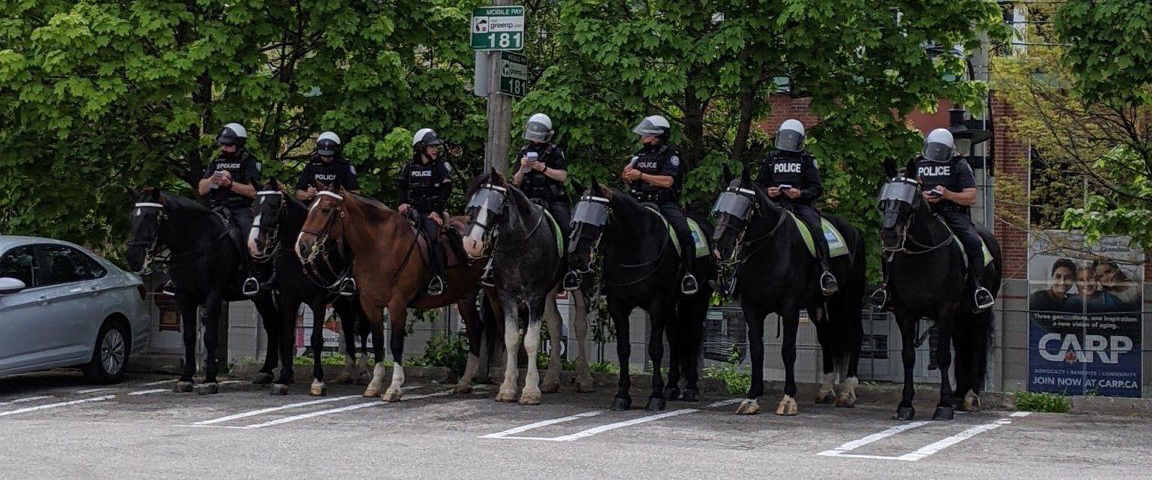On Wednesday May 19th, the City of Toronto sent a massive force to clear the encampment at Lamport Stadium Park. Roughly 60 City of Toronto corporate security guards and police officers (including eight on horseback), six people in Hazmat suits, a handful of other city workers, two “claw” heavy excavators and three dump trucks were only able to clear one tent and two wooden shelters—about 10% of the encampment—after trying in vain for the better part of the day.
Five days prior, trespass notices had been posted at the encampment, threatening arrests and fines of up to $10,000 if residents didn’t leave the park.
Several of Lamport’s residents told us that they didn’t intend to leave and wanted their homes and belongings to be defended. Even those who were considering taking a hotel spot felt pressured to make an imminent decision.
The residents of Lamport encampment have chosen to live there for many reasons: there’s the proximity to the respite, where some have beds and can access showers or food occasionally, though it doesn’t currently provide a space for safe and supervised drug use. There’s the fact that encampment dwellings have been indispensable for social distancing, especially during outbreaks at the respite, a congregate setting. Importantly, there’s also a greater sense of autonomy and community support. When we recently asked a resident whether he wanted his tent defended, he replied, “It’s not my tent, man. It’s our tent.”
Around 8:30 AM, Streets to Homes showed up to offer spots in temporary shelter hotels. Contrary to the City of Toronto’s public statement on the day’s events, no residents were offered actual housing. By about 10:45 AM, about 30 police officers arrived on the west side of the stadium and the growing presence of supportive community members frustrated their repeated attempts to enclose the west side with caution tape.
A member of the City’s encampment division briefed residents around the eviction timeline, saying that they had until 6pm to pack their bags. But that deadline was disregarded once it became clear that other residents planned to stay put.
Police and security found themselves overwhelmed, so they changed tack and moved in on the less-populated area to the east of the stadium, where a tent and two wooden structures stood. Again frustrated in their attempts to put up caution tape, police surrounded the dwellings as their residents rushed to pack their belongings. As several community members went to the east to support residents, a city truck and a heavy excavator with a large claw attachment moved in, flanked by police. But “The Claw” was blocked by a crowd of supporters before it could reach the dwellings. Corporate security mandated that anyone who interferes with the clearing should be arrested. When community supporters attempted to create a buffer between residents’ dwellings and the police, police responded with two arrests. Meanwhile, a small crew of people began to throw out residents’ belongings without permission, and they felt the need to wear Hazmat suits to do it.
Mounted police moved in, and when a Lamport resident attempted to step in to defend a shelter, police punched him in the face and forced him to the ground, where he was trampled by several officers and shoved into a court services vehicle. He was later released from 14 Division with deep cuts and bruising on his face and body, after a crowd of supporters gathered outside demanding his release. But the release was contingent on the absurd condition that he doesn’t return to Lamport Stadium, where he lives. Two days later he was arrested again simply for walking around near Lamport in a blatant attempt to harass and intimidate him. He was then released again under the same conditions.
Police cracked down on supporters, punching some in the face and dragging others along the ground. A second “Claw” appeared and drove right up into the park from King Street, managing to maneuver the structures into a nearby dump truck. As supporters held up the clearing on the east side, a mass of roughly 150 supporters had formed a perimeter around several structures on the west, in anticipation of what was to come. But the police and city workers decided to retreat.
The Lamport encampment still stands today because of the incredible force of solidarity between community members and their unhoused neighbours.
Community supporters have been painted as “outside agitators” by Mayor John Tory and others, implying that we acted against the wishes of encampment residents. To be clear: our response flows from the relationships we’ve made with Lamport’s residents over the course of a year of delivering the daily humanitarian aid that the city refuses to provide.
Residents themselves defended their homes against the city – and we were there to help. Over the past couple of days, residents have said that they were proud to have fought back against the city and asked us to bring an even greater response next time.
Much of the coverage has highlighted the extreme state violence enacted against residents, community members, and advocates. While important, this coverage tends to overlook the fact that the majority of residents’ homes were effectively and collectively defended. Just as the City of Toronto remains hellbent on clearing Lamport Stadium, we will continue to support our neighbours in encampments as they refuse to be forcibly displaced.
It’s time to step up and stand with your unhoused neighbours. The City has indicated that they’ll be back again soon, and we’ll be ready.
Encampment Support Network
[hr gap=”10″]
Get People’s Voice delivered to your door or inbox!
If you found this article useful, please consider subscribing to People’s Voice.
We are 100% reader-supported, with no corporate or government funding.




